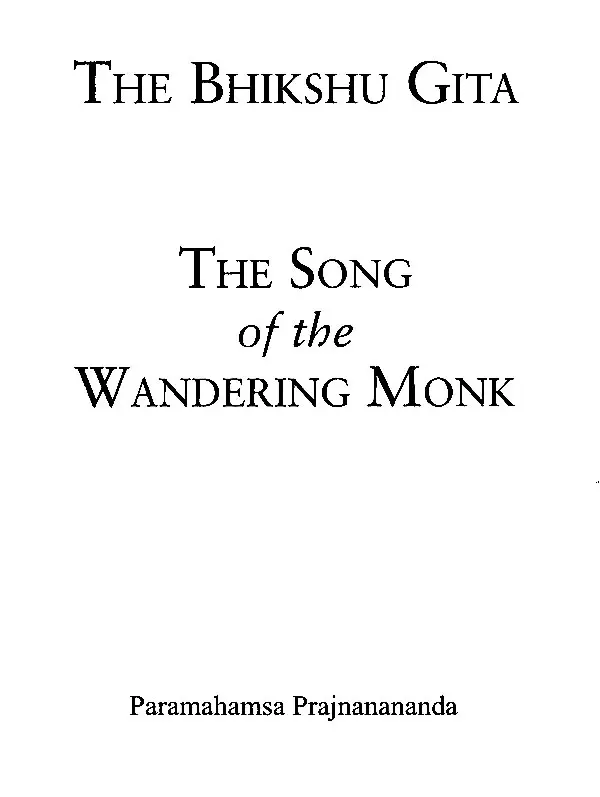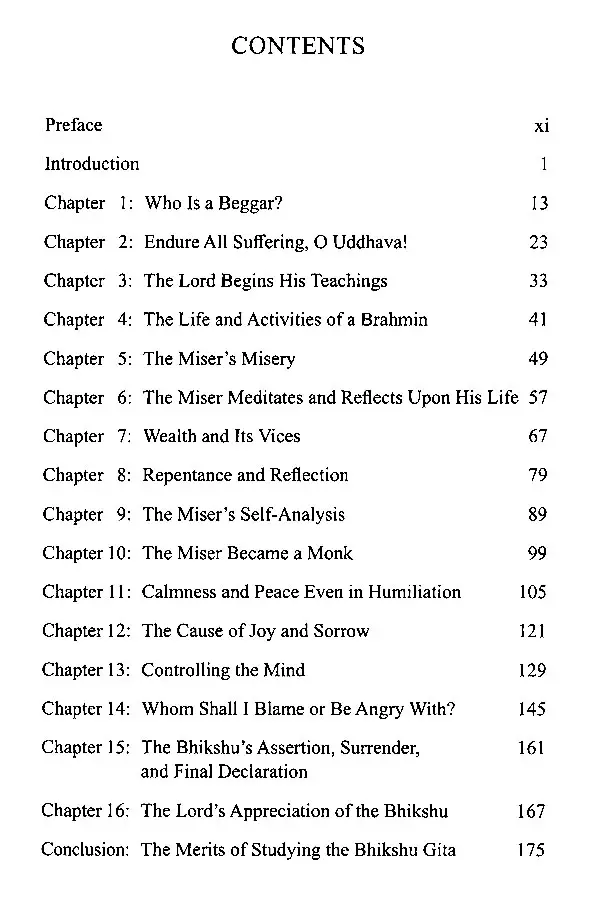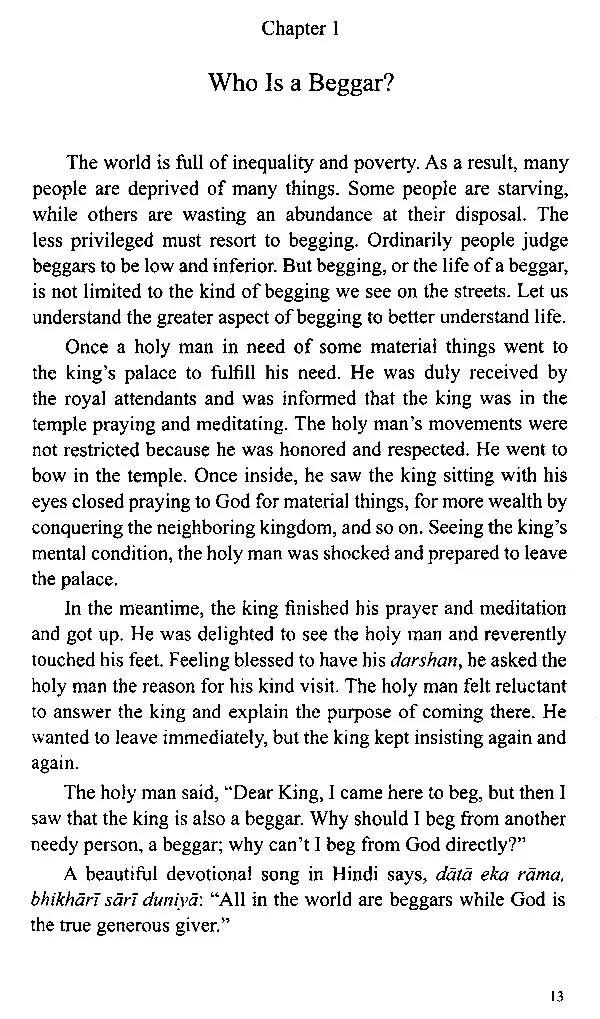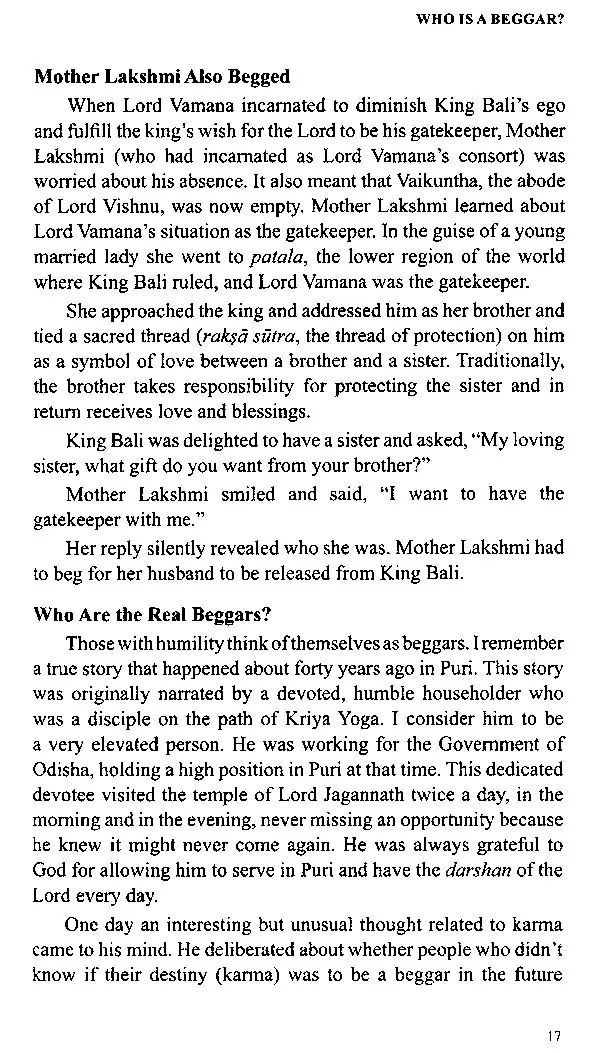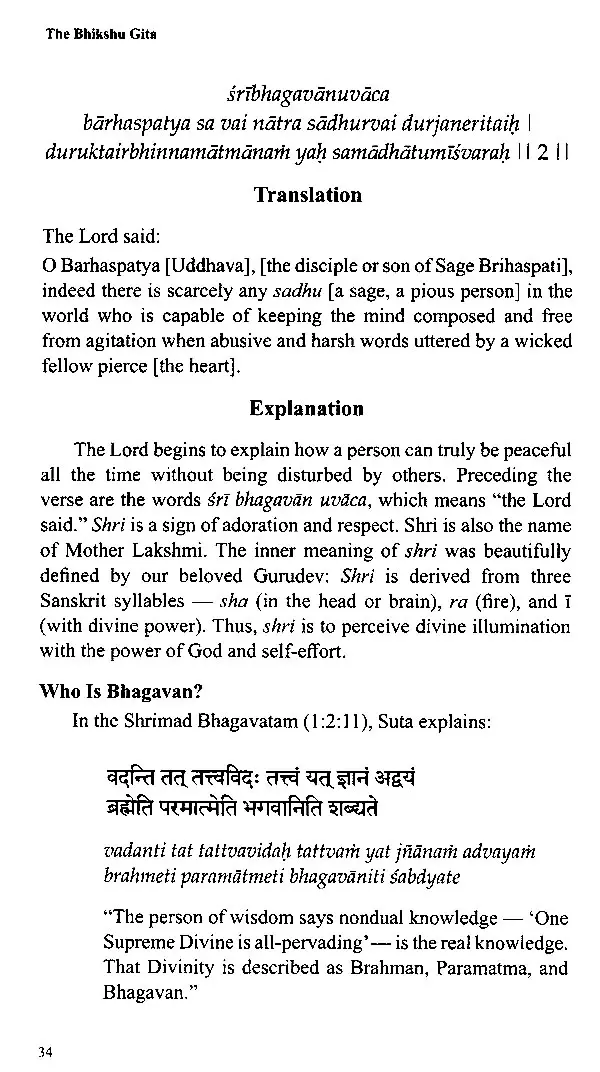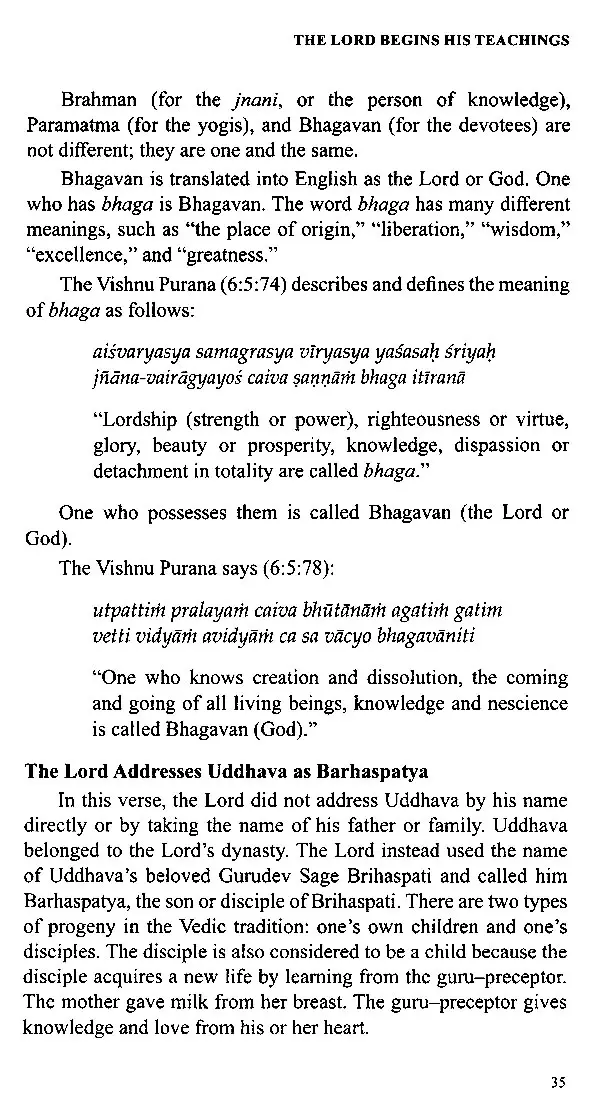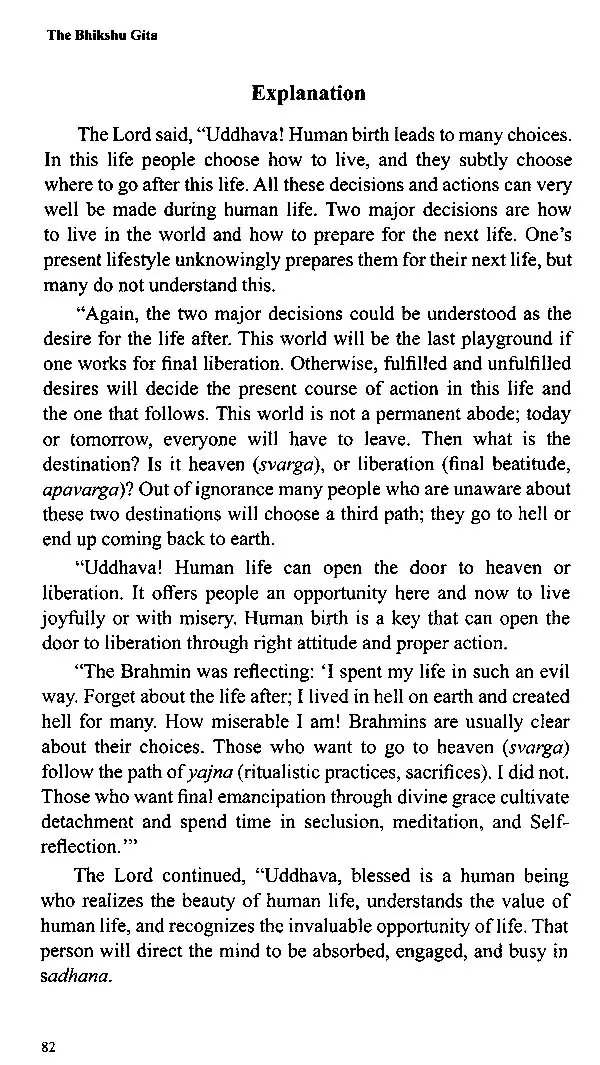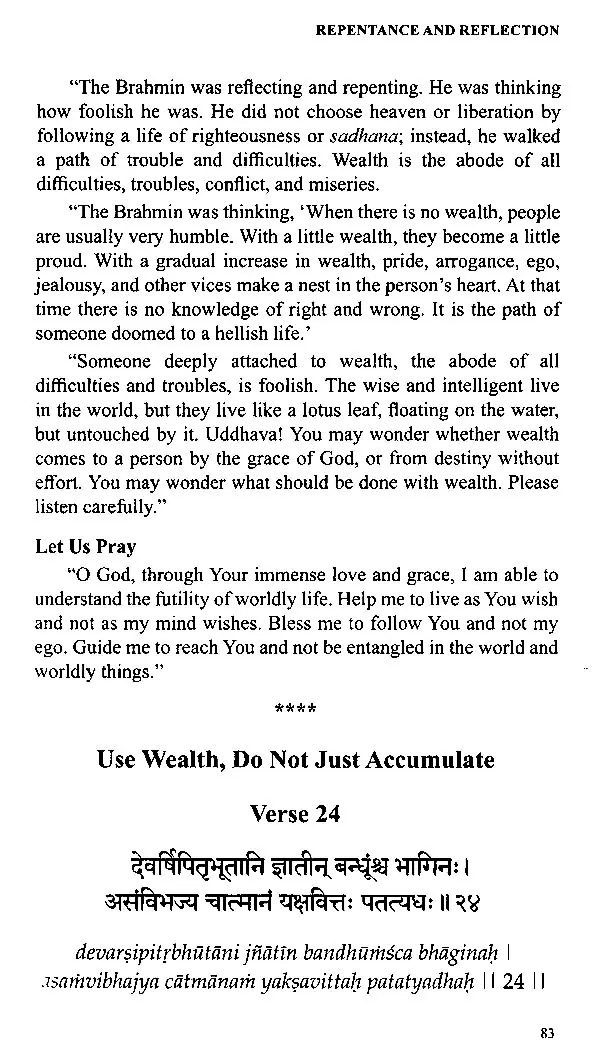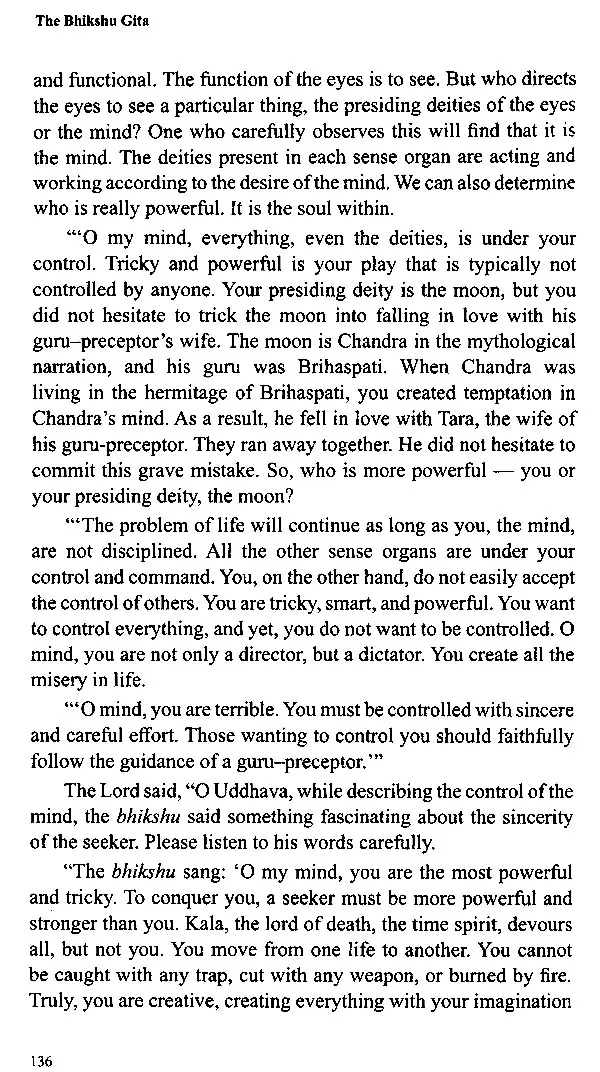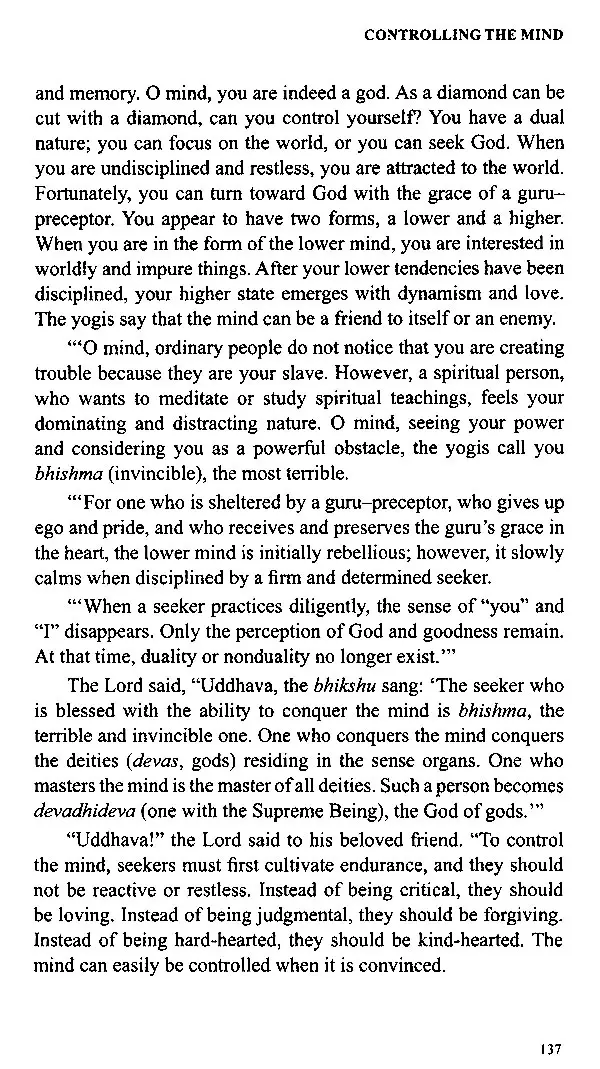
The Bhikshu Gita- The Song of The Wandering Monk
Book Specification
| Item Code: | UAI585 |
| Author: | Paramahamsa Prajnanananda |
| Publisher: | Prajna Publications, Kolkata |
| Language: | English |
| Edition: | 2021 |
| ISBN: | 9783990001561 |
| Pages: | 201 |
| Cover: | PAPERBACK |
| Other Details | 8.50 X 5.50 inch |
| Weight | 210 gm |
Book Description
Where do you store your treasure, in heaven or on earth? Is your well-being and happiness based on God and Truth, or on money and possessions? The desire for wealth takes root at an early age; in no time an intense longing becomes our foremost aspiration. Our families, our friends, and our divine duty to those in need take a back seat to our insatiable greed. Greed has a corrosive quality that erodes our inner beauty, corrupts our moral fiber, and destroys our relationships.
It may seem that greed is a modern disease. While greediness is undeniably more prevalent and destructive today, this invasive weed has been with us for ages. The ancient Bhikshu Gita scripture from India tells a timeless story about a mean-spirited miser's unquenchable thirst for money that ultimately leaves him destitute and alone. Thankfully, this story has a happy ending. Through his agony and deep reflection an inner light emerges that reveals his past mistakes and transforms him. The Bhikshu Gita masterfully teaches the simple lesson we are here to learn: The only treasure worth seeking is the eternal treasure.
The Bhikshu Gita: The Song of the Wandering Monk is a dialogue between Lord Krishna and his beloved friend Uddhava. Paramahamsa Prajnanananda shares a delightful yer insightful commentary. His penetrating translation and teachings illuminate the wisdom of the Lord's last message for humanity about living with detachment, forsaking emotional reactions, and completely loving God.
Who does not suffer? Suffering is divine grace. There was once a God-intoxicated monk in Rishikesh who was well versed in spiritual texts. Many monks and renunciants came to study scriptures under his guidance. One day while the monk was teaching, a businessman from Mumbai came to pay his respects with baskets of fruits, flowers, and other useful wares. The man patiently waited until the holy man finished his discourse. When the lesson was finished, the businessman approached the monk and bowed at his feet with all his offerings.
The holy man asked, "How are you?"
The businessman replied, "By your grace everything is fine. The business is going well. The son is married. The daughter-in law is extremely beautiful and humble."
"There is no problem or any sort of suffering?" the holy man asked.
The businessman said, "O adorable one, through your grace, everything is fine."
Upon hearing this, the holy man responded strangely, "Take away your gifts and go away. You are not a spiritual person. I do not want anything from you!"
All were shocked by his unusual behavior. The monk then explained, "Life without suffering is no life. In life, suffering leads to awakening. Through suffering we remember God. During pleasurable and good times, we ignore and forget God. Suffering and sadness bring us closer to God."
Life is suffering, but it can be made divine through sadhana (spiritual practice). A sincere seeker prays for more suffering and more alertness, Humbly a seeker prays, "O God, give me troubles and difficulties, but allow me to remember You and love You through every suffering."
While we are suffering, we exhaust our bad karmas. During joy. happiness, and pleasure our balance of good deeds is exhausted. In this world we find a good number of great people passing through a lot of suffering, but they endure and forbear. As a result, they attain divine grace.
Two forms of suffering affect us: The first is our own suffering from our own karma or the behavior of others; the second is the pain and sadness from others' suffering. The first type is common. Most people and other living beings suffer because of their own actions. Whereas perceiving the pain and suffering of others is a quality of good and noble people. They suffer because others are suffering.
The Bhagavad Gita describes Arjuna's dejection. The Yoga Vashistha expresses Lord Rama's grief. In the Chandi (Devi Mahatmya) King Suratha and the businessman Samadhi both pass through similar distress. Through the grace of a guru preceptor they all received the training and proper understanding to overcome their adverse conditions and become established in Self-knowledge.
Gautama suffered and became seriously contemplative when he saw an old person, the diseased, and the dead. It is a typical picture of life in this world. Before Gautama's distress, few acknowledged the misery of life or sought the remedy. When Gautama found the remedy, he taught humanity the four noble truths and became the Buddha, the Enlightened One.
Sage Vyasadeva is an incarnation of the Lord and a marvelous teacher. Toward the end of the Dvapara Yuga, he took a bath in the river Saraswati at sunrise and then sat in a silent and secluded place. He had a vision of the future and felt deep compassion in his heart for the people. They would have a shorter life span of 120 years maximum. Their memory power would be weak, and they would be incapable of living with values and virtues. To help them face such changing conditions, he compiled the Vedas and authored many scriptures. His devoted disciples carried out his work of spreading knowledge in the right manner.
On another day he sat on the bank of the river Saraswati feeling incomplete and despondent. An overwhelming sadness arose within him. He was unable to find the cause or the cure.
Fortunately, as a divine providence, Sage Narada was traveling through the area at that time. Seeing him approaching, Sage Wasadeva stood up to honor and receive him with deep respect and adoration.
As soon as their discussion began, Sage Narada asked Sage Vyasadeva about his mental state. Sage Vyasadeva narrated what he was feeling. Sage Narada advised him to meditate upon the Lord's divine leela and write something that everyone could read to help them practice the path to the Divine.
Following the advice and teachings of Sage Narada, the Shrimad Bhagavatam was born from the hands of Sage Vyasadeva, This revered text has become a solace to people with worldly suffering. The entire scripture of eighteen thousand verses is divided into twelve books.
The eleventh book is the most crucial part, containing practical teachings for human beings. In this eleventh book the majority of the dialogue is between Lord Krishna and his beloved friend and companion Uddhava. This book is also known as the Uddhava Gita. It contains the Lord's last teachings, occurring only a few days before his exit from the world.
The text of the Uddhava Gita contains two more Gitas. One is the Avadhuta Gita, a dialogue between King Yadu and Avadhuta, a God-intoxicated, wandering monk. The other one is the Bhikshu Gita, the life and understandings of another wandering monk.
The Bhikshu Gita is relatively small with only sixty-two verses. However, its message is very pragmatic with a deep understanding of life and its real goal. I hope this book will help seekers on the spiritual path to live with detachment by developing endurance and divine commitment.
Since ancient times spiritual education in India was imparted more in poetic form than in prose. The Vedas contain poetic descriptions of the highest spiritual truth. The best example of India's spiritual teachings as poetic narrations are the Gitas. The meaning of gita is "the song." When teachings are in poetic form, they are easy to recite, memorize, and recollect. Even if one does not understand the message, one can sing the verses in a general sense.
There are many Gitas, out of which the most prominent is the Bhagavad Gita. It is called "the Gita" for short. In total, a few dozen Gitas exist. Mostly the Gitas are associated with the name of a teacher. The Bhagavad Gita, the song of God, is associated with the teacher Lord Krishna, an incarnation of God. The Ashtavakra Gita is the teaching of Sage Ashtavakra to King Janaka; while the Avadhuta Gita is the instruction of Avadhuta, the ever-free. The Guru Gita is dedicated to the guru-preceptor; the central theme of discussion is the guru, although it contains the teachings of Lord Shiva to Mother Parvati.
The exception is the Uddhava Gita, which is dedicated to the disciple, the pupil, not to the teacher. The Uddhava Gita is the teaching of Lord Krishna to his beloved friend Uddhava. It is part of the Shrimad Bhagavatam. Some spiritual masters describe the eleventh book (ekadasa skandha) of the Bhagavatam, whose major part is the Uddhava Gita, as the book of liberation, the mukti skandha, because it discusses spiritual enlightenment. The eleventh book consists of thirty-one chapters; chapters six to twenty-nine are called the Uddhava Gita. It is comprised of one thousand and eighty verses.
Lord Krishna is a universal teacher. He followed the instructions of his guru-preceptor, Sage Sandipani, and communicated his knowledge to worthy disciples as a token of his reverence for the guru. This was his guru daksina, the love offering to a guru preceptor. Lord Krishna had two prominent disciples and coincidentally both were his cousins. One was Arjuna, whom most people know from the Bhagavad Gita. The other one was Uddhava in the Bhagavatam, an important personality and a very close companion of the Lord.
It is interesting to note that both disciples, Arjuna and Uddhava, were cousins and friends of Lord Krishna. Arjuna was the middle Pandava, the youngest son of Mother Kunti. Kunti was the sister of Vasudeva, the father of Lord Krishna. Kunti's real name was Pritha, but her name was changed to Kunti when King Kuntibhoja adopted her as his daughter. Kunti was thus Lord Krishna's aunt.
Uddhava, on the other hand, was the son of mother Kamsă and father Devabhaga. Uddhava's father was the younger brother of Vasudeva, the father of Lord Krishna. Not only that, but mother Kamsa was also the cousin of Devaki, Lord Krishna's mother. In other words, Lord Krishna and Uddhava were born into the same clan.
King Kamsa and His Sister Kamsa
To understand Kamsa, Uddhava's mother, we must first know about Kamsa. The feminine form of Kamsa is Kamsa. Kamsa, the evil king, was the maternal uncle of Lord Krishna and Uddhava. He imprisoned Lord Krishna's parents and killed their children after he heard that their son would be the cause of his death. Lord Krishna was the eighth child.Kamsa and Kamsa come from two root verbs. The first root verb is kams, which means "to go," "to destroy," and "to command." Hence, the word Kamsa implies that he had movement everywhere. As a powerful person he caused a lot of destruction. Kamsa as a king also commands. Kamsa (Kamsaa, having one extra a at the end) was not like Kamsa, her brother. Kamsa was going everywhere, commanding and destroying. Conversely, Kamsa was peaceful, quiet, and not the cause of destruction.
What is it within us that is going everywhere, destroying? It is our insatiable mind.
Let us understand the second meaning. Kamsa or Kamsa also comes from the root verb kam, which means "to desire," "to have passion and lust" (vasana). Desires move in us and make us move; they destroy our peace, and they direct us to go there, do this, sit near him or her, and talk. So, the simple meaning of Kamsa is "desire," and desire can be of two kinds.
The first kind of desire is impure desire that makes us worldly. It prompts us to seek sense pleasure and enjoyment. The second kind is desire for spirituality, evolution, meditation, good company. and so on. This is good desire.
Kamsa and Kamsă were two different personalities, one representing evil, and the other, goodness and love. Although from the same root verb kam, they represented two qualities present in every person one negative and the other positive. Every spiritual seeker should love good qualities and cultivate them daily. Thus, Kams, the mother of Uddhava, represents spiritual desire.
Meaning of Devabhaga
The father of Uddhava was Devabhaga. The name Devabhaga consists of two words, deva and bhaga. Bhaga implies "the portion." Suppose you are eating a meal with someone. You take one portion, and the other person takes the other portion. Bhaga is a "part," "portion," or "parcel." Deva means God. Together, the two words mean "to offer to God." When we eat, we should first offer the food to God and then consume it with love and prayer as consecrated food. Devabhaga represents bringing God into our lives first and then living in the world as the children of God.Deva means the "celestial" or "deity." The deities and celestials are present in our bodies in the chakras and sense organs along with the four inner instruments of mind, intellect, ego, and memory. To live a life of enjoyment without remembering the presence of the deities and celestials is like being a thief. Remembering them and thanking them during every moment of life is divine. Devabhaga also refers to properly giving due respect to the celestials and deities. **Contents and Sample Pages**
